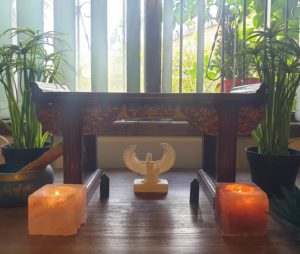
Image © Scott Rose / Kemetic Blog – All Rights Reserved.
It’s hard to believe nine months have passed, since I last posted an update on the Evolution of my Kemetic Altar and Shrine series!
So much has been happening, both in the world and in every sphere of my own life. I’ve only been able to blog on about 50% of it, it seems. I’ve been acquiring plenty of Egyptian stuff as I fondly call these items, which are far more sacred than sundry, and have also been building a modest knowledge-base on ancient Egypt and Kemeticism. My reading list faces an incredible barrier due to uni commitments (as I’m embarking on an EN to RN pathway in nursing — part time). As such, I am only aiming to complete one or two Egyptology books per year at this stage. Slow burn, I know, but I promise the book reviews will be thorough! See my latest book review here.
What I am never short on, of course, are Subjective Mystical Experiences and Encounters (SMEEs). Hanging with the netjeru is my forté and they never cease to amaze me! My best encounters with the deities always seem to be the unexpected ones. I’m minding my own business and wham! Something wonderful happens, that I couldn’t possibly concoct on my own, even if I wanted to. I love this aspect of my life with the netjeru. It’s incredibly rewarding and yet, I’m simultaneously aware that we’re only scratching the surface.
There’s still so much to learn from these fantastic beings, whom we know as gods. You can never learn enough about ancient Egypt and its religion; you can never experience everything there is to experience with the netjeru. There’s always more to discover. Believe it or not, the netjeru are relaying to me that they feel the same way about us, as they learn more about themselves through encouraging and witnessing our growth. “That’s why we’re here.” The god, Atum has said to me. ‘We’ meaning all of us. We are all here to learn from one another and grow together.
As far as I can tell, the netjeru look at their relationship with humanity as a reciprocal one. It’s not one-sided, at all. These understandings have given me a great deal of insight into how we see the pagan gods versus how they see themselves. This is an intuitive understanding, based on personal relationships and SMEEs with the ancient Egyptian deities. While a decided departure from orthodoxy, I still revere the gods! My Kemetic practice is informed by them, by the relationship cultivated with them and by my ability to perceive their reality (which is still only a mild to moderate ability). I am not informed merely by historical record, though I would encourage practitioners to blend and balance their approach.
Some people like to Netflix and Chill and I do that, too when work bl**dy exhausts me! Yet to Netjeru and Chill is far more enlightening and good for the soul. Getting back to my Kemetic altar and shrine (I ramble, sometimes) I’ll go through each item and where I got it, in case anyone else feels inspired. My point, by the way, is your Kemetic altar and shrine is a platform for your interaction with the netjeru; it holds a sacred space and energy where gods and humans meet.
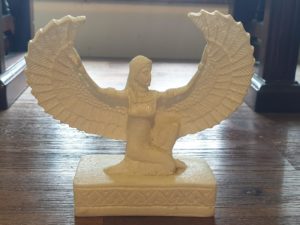
© Scott Rose / Kemetic Blog – All Rights Reserved.
Isis Statue
This lovely Isis / Aset statue is my very first statue ever. I chose her based on a vision I was given of a white marble statue of Isis and this is the most approximate statue I could find. I got her on Etsy from a shop called Dee Egypt. Dee Dee also has a physical shop location in Texas. Browse her shop for a mother-load of Egyptian stuff. To be honest, I cannot recall how much the statue cost. Google it and I’m sure you’ll be pleasantly surprised!
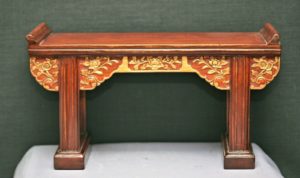
© Scott Rose / Kemetic Blog – All Rights Reserved.
Shrine
This wooden shrine I’m rather proud of as it’s a unique find. It came from an older person who was selling many of his belongings after a lifetime of collecting. He got this shrine on a business trip to China many years ago and it’s now an antique. My suggestion to anyone looking for a similar item is to do an online shopping search for ‘shrine’ and see what pops up. Many religions such as Buddhism, Hinduism and Shintoism use shrines such as the one pictured above and can be easily adapted to create your own Kemetic altar and shrine. Plus, on Etsy, you can easily find a custom-made Kemetic altar and shrine, many with icons of specific deities. This one fell in the AUD$150 range, which is quite reasonable considering it’s an antique.
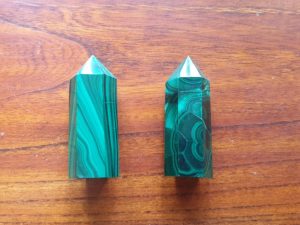
© Scott Rose / Kemetic Blog – All Rights Reserved.
Malachite Generators
These pinky-sized generators are from eBay and as with all quality malachite, they were on the expensive side, in the neighbourhood of AUD$145 for both. Luckily in Australia, we have AfterPay and I’ve become the Pharaoh of AfterPay, since becoming a Kemetic practitioner. If you’re offering crystals and semi-precious stones to the gods, aim to get the best quality you can afford. These malachite generators channel pure life-force energy and this energy is a constant source of offering to the netjeru. You’re better off getting a smaller piece of a high-quality specimen, than a larger piece of low-quality, if that makes sense.
In ancient Egypt, the afterlife included an eternal paradise that resembled our world but with no pain or suffering and was sometimes called the field of malachite (see the 2010 article, Colour Green by J Hill). Malachite was used extensively in ancient Egyptian cosmetics and jewellery and was a stone of life, death and resurrection with a strong connection to Osiris.
Keep your space clear and energised (with other offerings like music, candles, food and drink offerings, libations, natron or salt and flowers, herbs, resins, incense and a sistrum) and your crystals will be happy, not to mention the netjeru. Remember, the better the energy you can cultivate, the easier it will be for the netjeru to anchor themselves at the Kemetic altar and shrine you’ve constructed for them. You can create a positive portal or gateway for the netjeru that allows for easy, two-way access and communication.
From my own perspective on Kemetic practice, energy is everything! The nature of the netjeru is to nurture but they appreciate nurturing, too. If you do that nurturing, through offerings and worship, you make it easier and more beneficial for the netjeru to be an active part of your life. They in turn, will nurture you with their guidance, wisdom and protection. If you do not have much sensitivity to energies, don’t worry. You can develop these abilities through ritual, prayer and meditation. Your Kemetic altar and shrine is the perfect place to do just that.
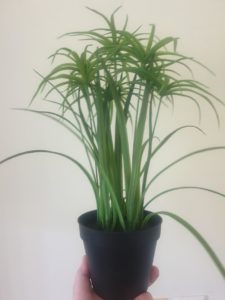
© Scott Rose / Kemetic Blog – All Rights Reserved.
Artificial Papyrus Plants
Though rare, you can find artificial papyrus plants. Some are rather large, attempting to mimic the real Cyperus papyrus in size, which grow to 10 feet. Even a 3 foot artificial papyrus may be too large for your needs, not to mention expensive. The ‘plants’ I selected came from Ikea and are probably about 30+ cm high. They are the most inexpensive addition to my Kemetic altar and shrine so far, at around AUD $13 each. Interestingly enough, faux plants have surprisingly good energy, which I never knew until I gave them a go.
Like malachite, papyrus was also a symbol of rebirth in ancient Egypt (see the 2015 article, Papyrus in Ancient Egypt by Janice Kamrin). According to Kamrin:
“In ancient Egyptian cosmology, the world was created when the first god [perhaps not by coincidence, Atum] stood on a mound that emerged from limitless and undifferentiated darkness and water [Nu or Nun], a mythical echo of the moment each year when the land began to reappear from beneath the annual floodwaters. Papyrus marshes were thus seen as fecund, fertile regions that contained the germs of creation.”
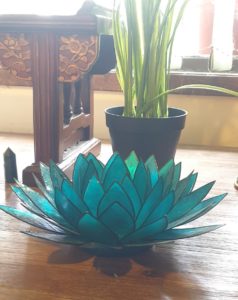
© Scott Rose / Kemetic Blog – All Rights Reserved.
Blue Lily Tealight Holders
These beautiful blue lily tea light holders are made of Capiz shell and come from the Philippines. As a vegetarian, I usually stay away from animal products. From my understanding though, these creatures aren’t harmed when Capiz shell is harvested but I honestly don’t know how accurate the information on an eBay listing really is!
A quick Google search revealed positive and negative claims about Capiz shell. Ethical harvesting and sustainability are issues we should all care about and I wish I’d looked deeper into it before buying, to be completely honest. On the bright side, I don’t feel any vibrations of trauma. If there were, believe me, I’d know about it at 3 am when confronted by angry or upset divas and that hasn’t happened yet. In the future, I’ll be more careful before buying anything of animal origin. Obviously, this is not an item for staunch vegans. They were around AUD$30 each.
Also, the Himalayan salt crystal tea light holders help dissolve negative energy and reduce interference from exogenous sources — which can sometimes occur (that’s a whole other post I must do, sometime). The same can be said for the singing bowl, which I currently use as I do not yet have a sistrum.
As many of you know may know, I’ve recently moved. These photos were taken at my old place, in the bedroom where contact with the netjeru (especially Aset / Isis, in particular) first occurred. On that account, it was a bit sad to leave the place; I lived there for many years but it’s onward and upward with a new partner, a new place and the same wonderful deities. This, of course, means I’ll have to post another update soon. Thank you, for reading Kemetic Blog and an update on the evolution of my Kemetic altar and shrine. Stay safe and well. Happy Mother’s Day!
𓆸
© Scott Rose / Kemetic Blog – All Rights Reserved.
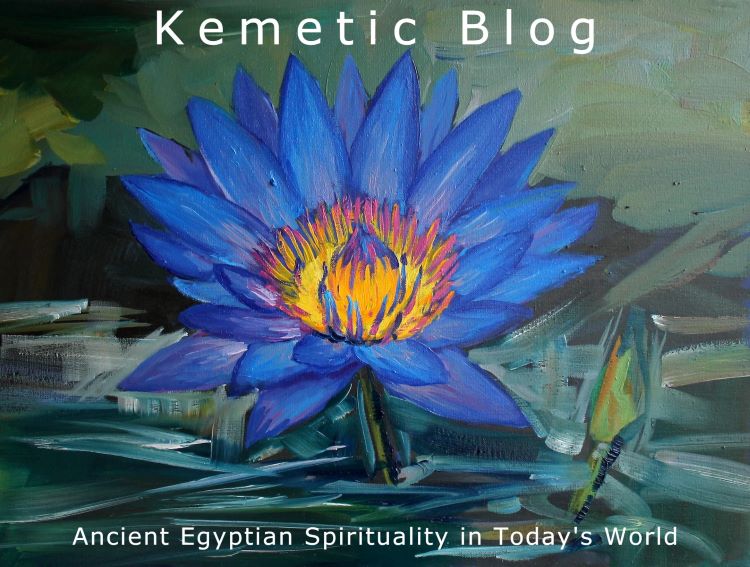
1 Comment
Protect Yourself from Psychic Attack and Psychic Blocks
July 12, 2021 at 11:58 pm[…] a recent blog post, I said that energy is everything. Likewise, everything is energy. Physical reality is dense […]